Organisational Behaviour Report: Culture, Power, and Teams in Siemens
VerifiedAdded on 2020/10/22
|12
|3646
|271
Report
AI Summary
This report provides a detailed analysis of organisational behaviour within Siemens, focusing on the influence of organisational culture, power, and politics on individual and team behaviour. It examines the importance of a healthy workplace culture and how Siemens addresses employee needs and motivations. The report evaluates content and process theories of motivation, including Maslow's Hierarchy of Needs, equity theory, and expectancy theory, and their application in influencing employee behaviour. It further assesses the relationship between culture, politics, power, and motivation, highlighting the characteristics of effective and ineffective teams within Siemens. The analysis considers leadership styles, group development theories, and the impact of organisational behaviour philosophies on the workplace, providing insights into how Siemens aims to achieve its sales targets through effective team management and motivation strategies.
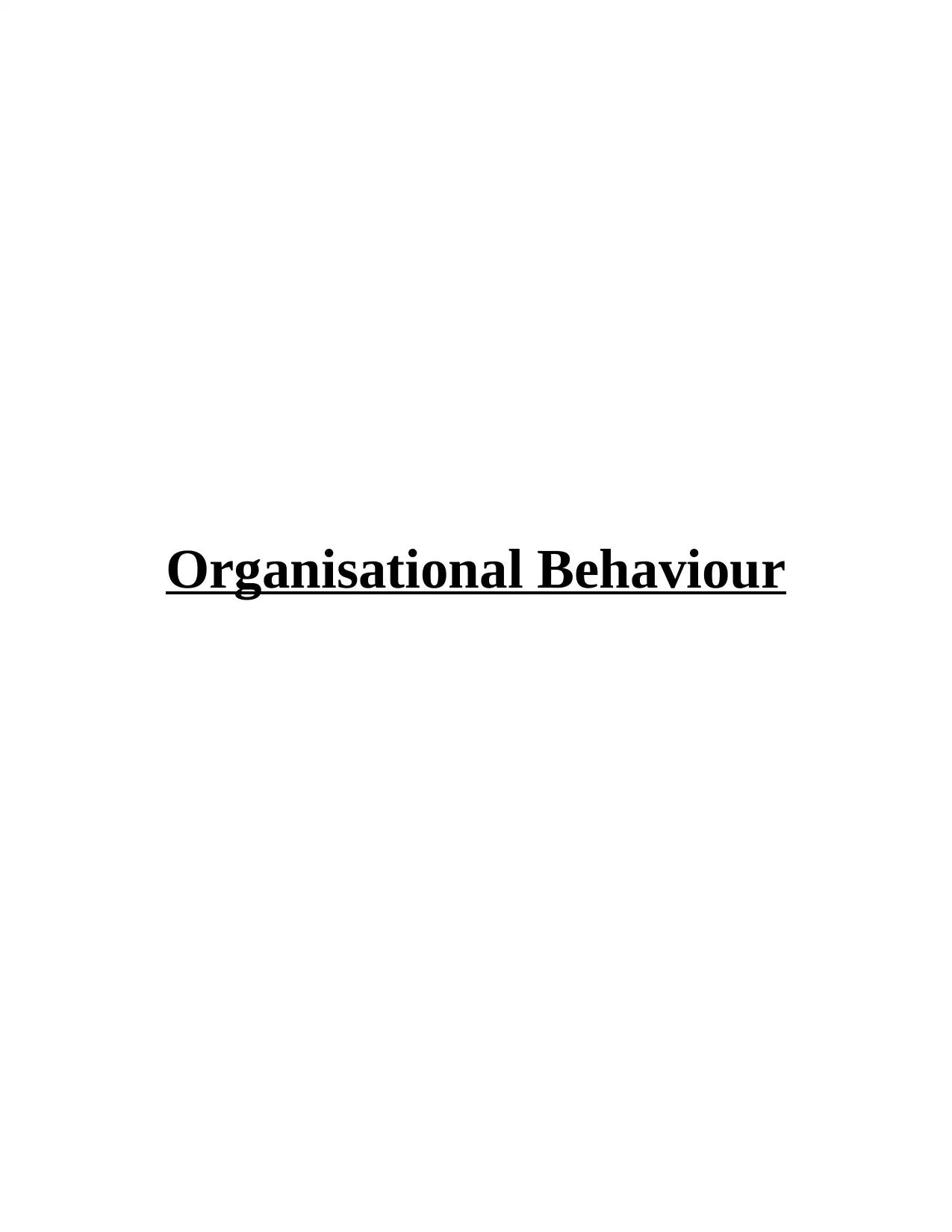
Organisational Behaviour
Paraphrase This Document
Need a fresh take? Get an instant paraphrase of this document with our AI Paraphraser
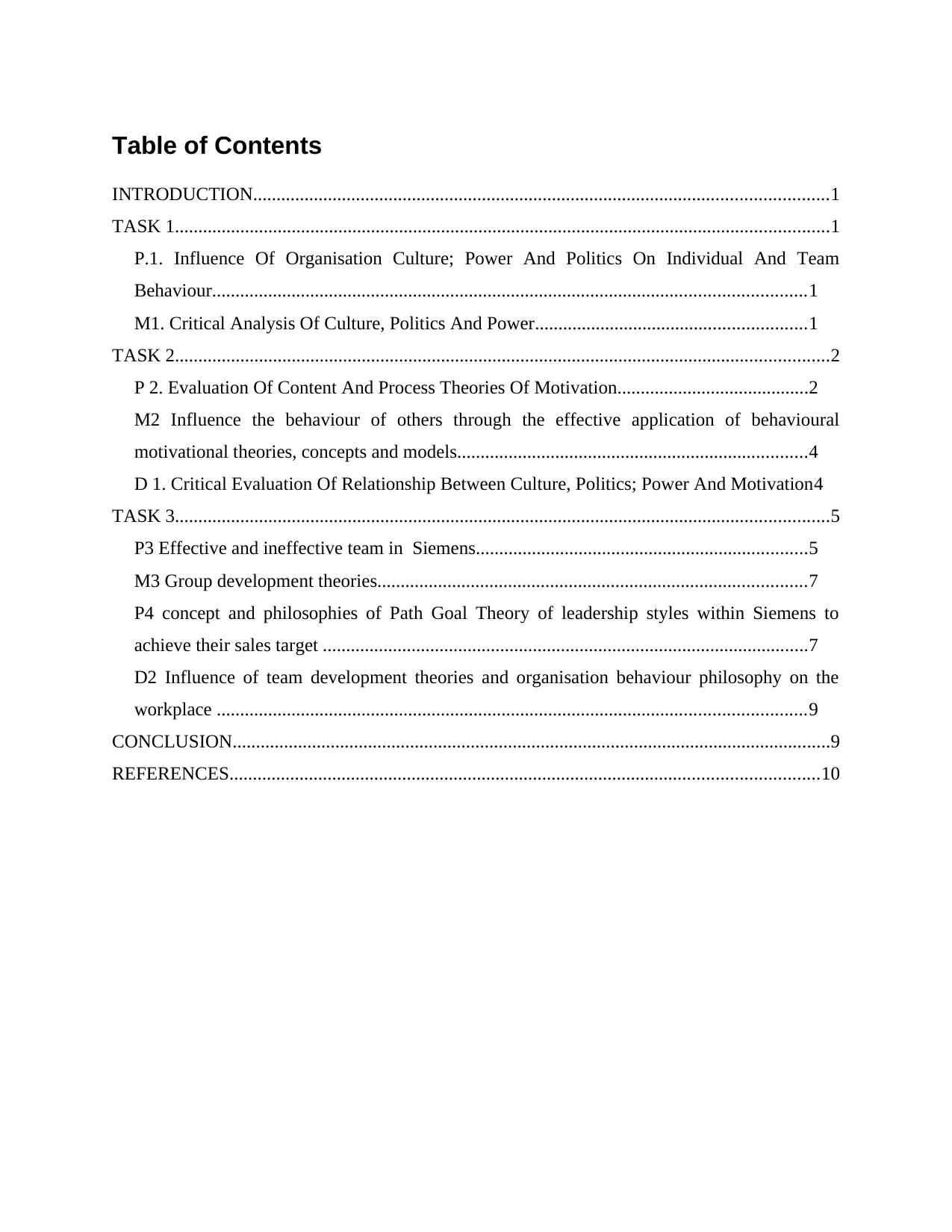
Table of Contents
INTRODUCTION...........................................................................................................................1
TASK 1............................................................................................................................................1
P.1. Influence Of Organisation Culture; Power And Politics On Individual And Team
Behaviour...............................................................................................................................1
M1. Critical Analysis Of Culture, Politics And Power..........................................................1
TASK 2............................................................................................................................................2
P 2. Evaluation Of Content And Process Theories Of Motivation.........................................2
M2 Influence the behaviour of others through the effective application of behavioural
motivational theories, concepts and models...........................................................................4
D 1. Critical Evaluation Of Relationship Between Culture, Politics; Power And Motivation4
TASK 3............................................................................................................................................5
P3 Effective and ineffective team in Siemens.......................................................................5
M3 Group development theories............................................................................................7
P4 concept and philosophies of Path Goal Theory of leadership styles within Siemens to
achieve their sales target ........................................................................................................7
D2 Influence of team development theories and organisation behaviour philosophy on the
workplace ..............................................................................................................................9
CONCLUSION................................................................................................................................9
REFERENCES..............................................................................................................................10
INTRODUCTION...........................................................................................................................1
TASK 1............................................................................................................................................1
P.1. Influence Of Organisation Culture; Power And Politics On Individual And Team
Behaviour...............................................................................................................................1
M1. Critical Analysis Of Culture, Politics And Power..........................................................1
TASK 2............................................................................................................................................2
P 2. Evaluation Of Content And Process Theories Of Motivation.........................................2
M2 Influence the behaviour of others through the effective application of behavioural
motivational theories, concepts and models...........................................................................4
D 1. Critical Evaluation Of Relationship Between Culture, Politics; Power And Motivation4
TASK 3............................................................................................................................................5
P3 Effective and ineffective team in Siemens.......................................................................5
M3 Group development theories............................................................................................7
P4 concept and philosophies of Path Goal Theory of leadership styles within Siemens to
achieve their sales target ........................................................................................................7
D2 Influence of team development theories and organisation behaviour philosophy on the
workplace ..............................................................................................................................9
CONCLUSION................................................................................................................................9
REFERENCES..............................................................................................................................10
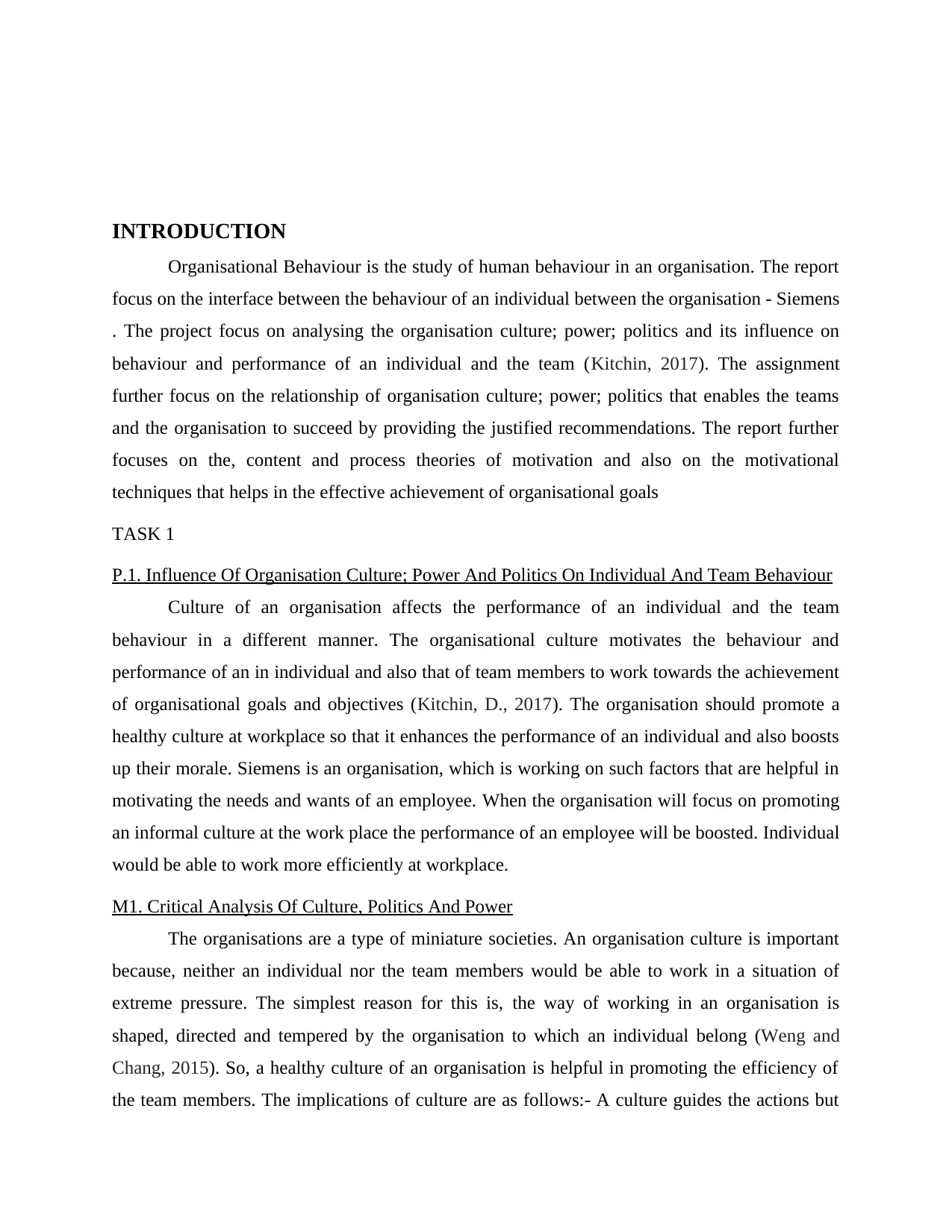
INTRODUCTION
Organisational Behaviour is the study of human behaviour in an organisation. The report
focus on the interface between the behaviour of an individual between the organisation - Siemens
. The project focus on analysing the organisation culture; power; politics and its influence on
behaviour and performance of an individual and the team (Kitchin, 2017). The assignment
further focus on the relationship of organisation culture; power; politics that enables the teams
and the organisation to succeed by providing the justified recommendations. The report further
focuses on the, content and process theories of motivation and also on the motivational
techniques that helps in the effective achievement of organisational goals
TASK 1
P.1. Influence Of Organisation Culture; Power And Politics On Individual And Team Behaviour
Culture of an organisation affects the performance of an individual and the team
behaviour in a different manner. The organisational culture motivates the behaviour and
performance of an in individual and also that of team members to work towards the achievement
of organisational goals and objectives (Kitchin, D., 2017). The organisation should promote a
healthy culture at workplace so that it enhances the performance of an individual and also boosts
up their morale. Siemens is an organisation, which is working on such factors that are helpful in
motivating the needs and wants of an employee. When the organisation will focus on promoting
an informal culture at the work place the performance of an employee will be boosted. Individual
would be able to work more efficiently at workplace.
M1. Critical Analysis Of Culture, Politics And Power
The organisations are a type of miniature societies. An organisation culture is important
because, neither an individual nor the team members would be able to work in a situation of
extreme pressure. The simplest reason for this is, the way of working in an organisation is
shaped, directed and tempered by the organisation to which an individual belong (Weng and
Chang, 2015). So, a healthy culture of an organisation is helpful in promoting the efficiency of
the team members. The implications of culture are as follows:- A culture guides the actions but
Organisational Behaviour is the study of human behaviour in an organisation. The report
focus on the interface between the behaviour of an individual between the organisation - Siemens
. The project focus on analysing the organisation culture; power; politics and its influence on
behaviour and performance of an individual and the team (Kitchin, 2017). The assignment
further focus on the relationship of organisation culture; power; politics that enables the teams
and the organisation to succeed by providing the justified recommendations. The report further
focuses on the, content and process theories of motivation and also on the motivational
techniques that helps in the effective achievement of organisational goals
TASK 1
P.1. Influence Of Organisation Culture; Power And Politics On Individual And Team Behaviour
Culture of an organisation affects the performance of an individual and the team
behaviour in a different manner. The organisational culture motivates the behaviour and
performance of an in individual and also that of team members to work towards the achievement
of organisational goals and objectives (Kitchin, D., 2017). The organisation should promote a
healthy culture at workplace so that it enhances the performance of an individual and also boosts
up their morale. Siemens is an organisation, which is working on such factors that are helpful in
motivating the needs and wants of an employee. When the organisation will focus on promoting
an informal culture at the work place the performance of an employee will be boosted. Individual
would be able to work more efficiently at workplace.
M1. Critical Analysis Of Culture, Politics And Power
The organisations are a type of miniature societies. An organisation culture is important
because, neither an individual nor the team members would be able to work in a situation of
extreme pressure. The simplest reason for this is, the way of working in an organisation is
shaped, directed and tempered by the organisation to which an individual belong (Weng and
Chang, 2015). So, a healthy culture of an organisation is helpful in promoting the efficiency of
the team members. The implications of culture are as follows:- A culture guides the actions but
⊘ This is a preview!⊘
Do you want full access?
Subscribe today to unlock all pages.

Trusted by 1+ million students worldwide
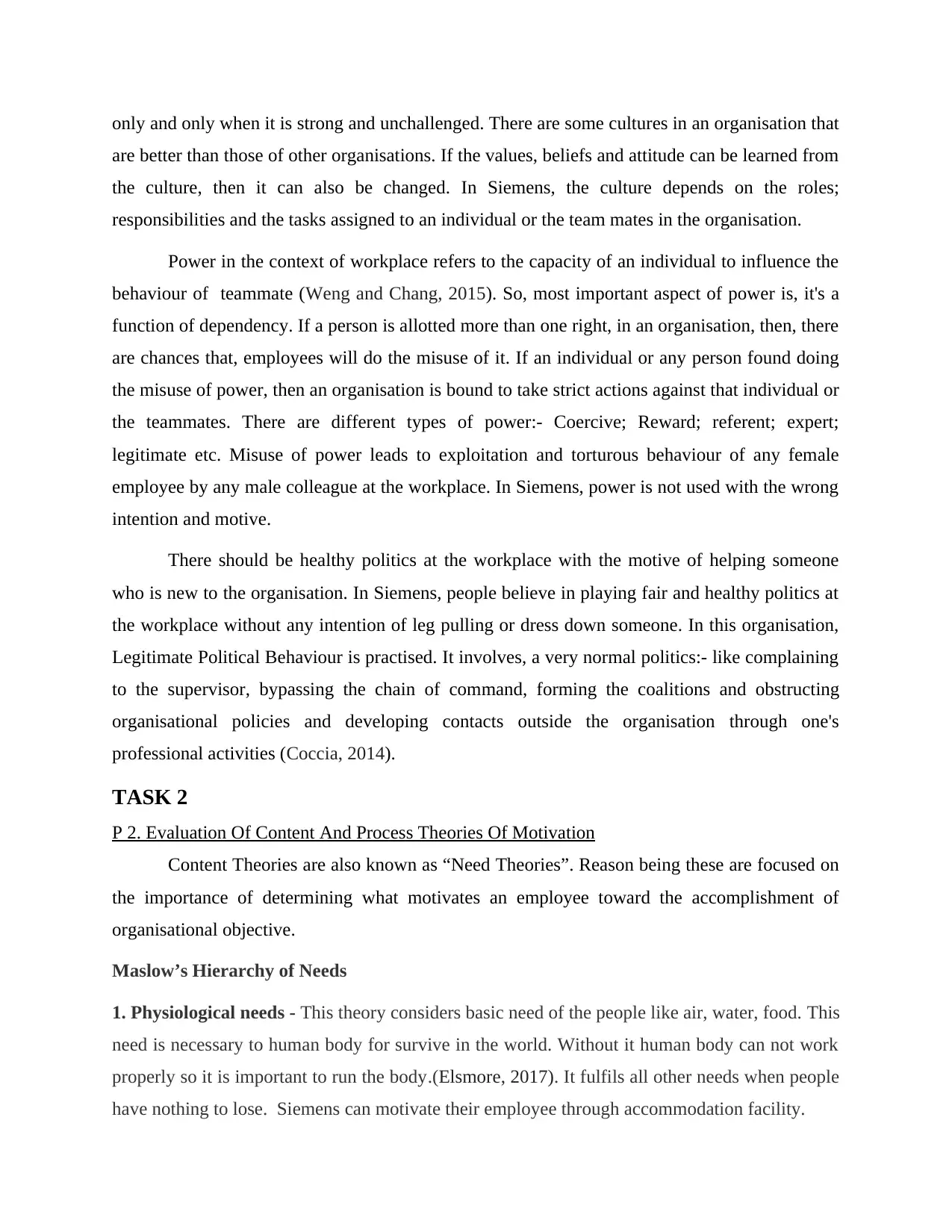
only and only when it is strong and unchallenged. There are some cultures in an organisation that
are better than those of other organisations. If the values, beliefs and attitude can be learned from
the culture, then it can also be changed. In Siemens, the culture depends on the roles;
responsibilities and the tasks assigned to an individual or the team mates in the organisation.
Power in the context of workplace refers to the capacity of an individual to influence the
behaviour of teammate (Weng and Chang, 2015). So, most important aspect of power is, it's a
function of dependency. If a person is allotted more than one right, in an organisation, then, there
are chances that, employees will do the misuse of it. If an individual or any person found doing
the misuse of power, then an organisation is bound to take strict actions against that individual or
the teammates. There are different types of power:- Coercive; Reward; referent; expert;
legitimate etc. Misuse of power leads to exploitation and torturous behaviour of any female
employee by any male colleague at the workplace. In Siemens, power is not used with the wrong
intention and motive.
There should be healthy politics at the workplace with the motive of helping someone
who is new to the organisation. In Siemens, people believe in playing fair and healthy politics at
the workplace without any intention of leg pulling or dress down someone. In this organisation,
Legitimate Political Behaviour is practised. It involves, a very normal politics:- like complaining
to the supervisor, bypassing the chain of command, forming the coalitions and obstructing
organisational policies and developing contacts outside the organisation through one's
professional activities (Coccia, 2014).
TASK 2
P 2. Evaluation Of Content And Process Theories Of Motivation
Content Theories are also known as “Need Theories”. Reason being these are focused on
the importance of determining what motivates an employee toward the accomplishment of
organisational objective.
Maslow’s Hierarchy of Needs
1. Physiological needs - This theory considers basic need of the people like air, water, food. This
need is necessary to human body for survive in the world. Without it human body can not work
properly so it is important to run the body.(Elsmore, 2017). It fulfils all other needs when people
have nothing to lose. Siemens can motivate their employee through accommodation facility.
are better than those of other organisations. If the values, beliefs and attitude can be learned from
the culture, then it can also be changed. In Siemens, the culture depends on the roles;
responsibilities and the tasks assigned to an individual or the team mates in the organisation.
Power in the context of workplace refers to the capacity of an individual to influence the
behaviour of teammate (Weng and Chang, 2015). So, most important aspect of power is, it's a
function of dependency. If a person is allotted more than one right, in an organisation, then, there
are chances that, employees will do the misuse of it. If an individual or any person found doing
the misuse of power, then an organisation is bound to take strict actions against that individual or
the teammates. There are different types of power:- Coercive; Reward; referent; expert;
legitimate etc. Misuse of power leads to exploitation and torturous behaviour of any female
employee by any male colleague at the workplace. In Siemens, power is not used with the wrong
intention and motive.
There should be healthy politics at the workplace with the motive of helping someone
who is new to the organisation. In Siemens, people believe in playing fair and healthy politics at
the workplace without any intention of leg pulling or dress down someone. In this organisation,
Legitimate Political Behaviour is practised. It involves, a very normal politics:- like complaining
to the supervisor, bypassing the chain of command, forming the coalitions and obstructing
organisational policies and developing contacts outside the organisation through one's
professional activities (Coccia, 2014).
TASK 2
P 2. Evaluation Of Content And Process Theories Of Motivation
Content Theories are also known as “Need Theories”. Reason being these are focused on
the importance of determining what motivates an employee toward the accomplishment of
organisational objective.
Maslow’s Hierarchy of Needs
1. Physiological needs - This theory considers basic need of the people like air, water, food. This
need is necessary to human body for survive in the world. Without it human body can not work
properly so it is important to run the body.(Elsmore, 2017). It fulfils all other needs when people
have nothing to lose. Siemens can motivate their employee through accommodation facility.
Paraphrase This Document
Need a fresh take? Get an instant paraphrase of this document with our AI Paraphraser
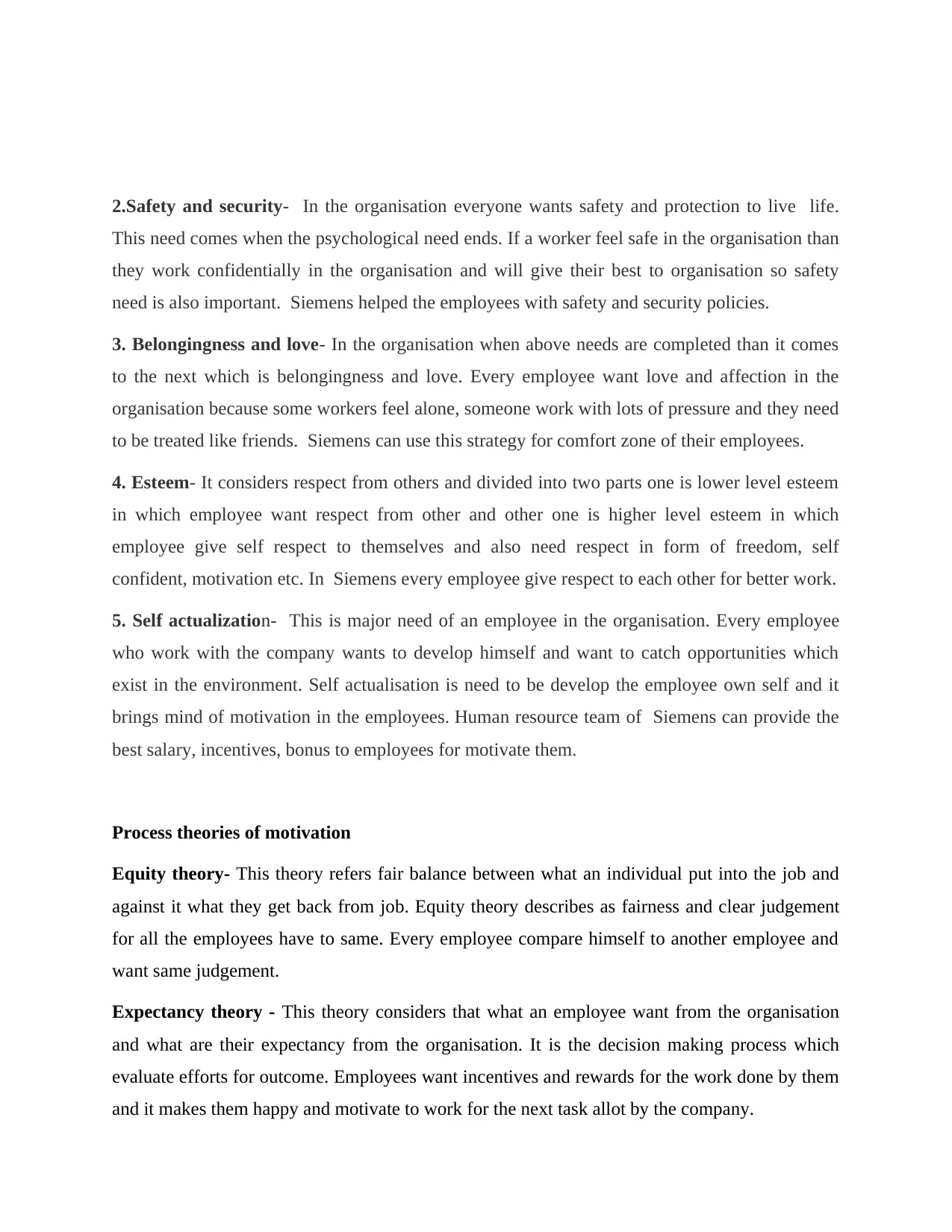
2.Safety and security- In the organisation everyone wants safety and protection to live life.
This need comes when the psychological need ends. If a worker feel safe in the organisation than
they work confidentially in the organisation and will give their best to organisation so safety
need is also important. Siemens helped the employees with safety and security policies.
3. Belongingness and love- In the organisation when above needs are completed than it comes
to the next which is belongingness and love. Every employee want love and affection in the
organisation because some workers feel alone, someone work with lots of pressure and they need
to be treated like friends. Siemens can use this strategy for comfort zone of their employees.
4. Esteem- It considers respect from others and divided into two parts one is lower level esteem
in which employee want respect from other and other one is higher level esteem in which
employee give self respect to themselves and also need respect in form of freedom, self
confident, motivation etc. In Siemens every employee give respect to each other for better work.
5. Self actualization- This is major need of an employee in the organisation. Every employee
who work with the company wants to develop himself and want to catch opportunities which
exist in the environment. Self actualisation is need to be develop the employee own self and it
brings mind of motivation in the employees. Human resource team of Siemens can provide the
best salary, incentives, bonus to employees for motivate them.
Process theories of motivation
Equity theory- This theory refers fair balance between what an individual put into the job and
against it what they get back from job. Equity theory describes as fairness and clear judgement
for all the employees have to same. Every employee compare himself to another employee and
want same judgement.
Expectancy theory - This theory considers that what an employee want from the organisation
and what are their expectancy from the organisation. It is the decision making process which
evaluate efforts for outcome. Employees want incentives and rewards for the work done by them
and it makes them happy and motivate to work for the next task allot by the company.
This need comes when the psychological need ends. If a worker feel safe in the organisation than
they work confidentially in the organisation and will give their best to organisation so safety
need is also important. Siemens helped the employees with safety and security policies.
3. Belongingness and love- In the organisation when above needs are completed than it comes
to the next which is belongingness and love. Every employee want love and affection in the
organisation because some workers feel alone, someone work with lots of pressure and they need
to be treated like friends. Siemens can use this strategy for comfort zone of their employees.
4. Esteem- It considers respect from others and divided into two parts one is lower level esteem
in which employee want respect from other and other one is higher level esteem in which
employee give self respect to themselves and also need respect in form of freedom, self
confident, motivation etc. In Siemens every employee give respect to each other for better work.
5. Self actualization- This is major need of an employee in the organisation. Every employee
who work with the company wants to develop himself and want to catch opportunities which
exist in the environment. Self actualisation is need to be develop the employee own self and it
brings mind of motivation in the employees. Human resource team of Siemens can provide the
best salary, incentives, bonus to employees for motivate them.
Process theories of motivation
Equity theory- This theory refers fair balance between what an individual put into the job and
against it what they get back from job. Equity theory describes as fairness and clear judgement
for all the employees have to same. Every employee compare himself to another employee and
want same judgement.
Expectancy theory - This theory considers that what an employee want from the organisation
and what are their expectancy from the organisation. It is the decision making process which
evaluate efforts for outcome. Employees want incentives and rewards for the work done by them
and it makes them happy and motivate to work for the next task allot by the company.
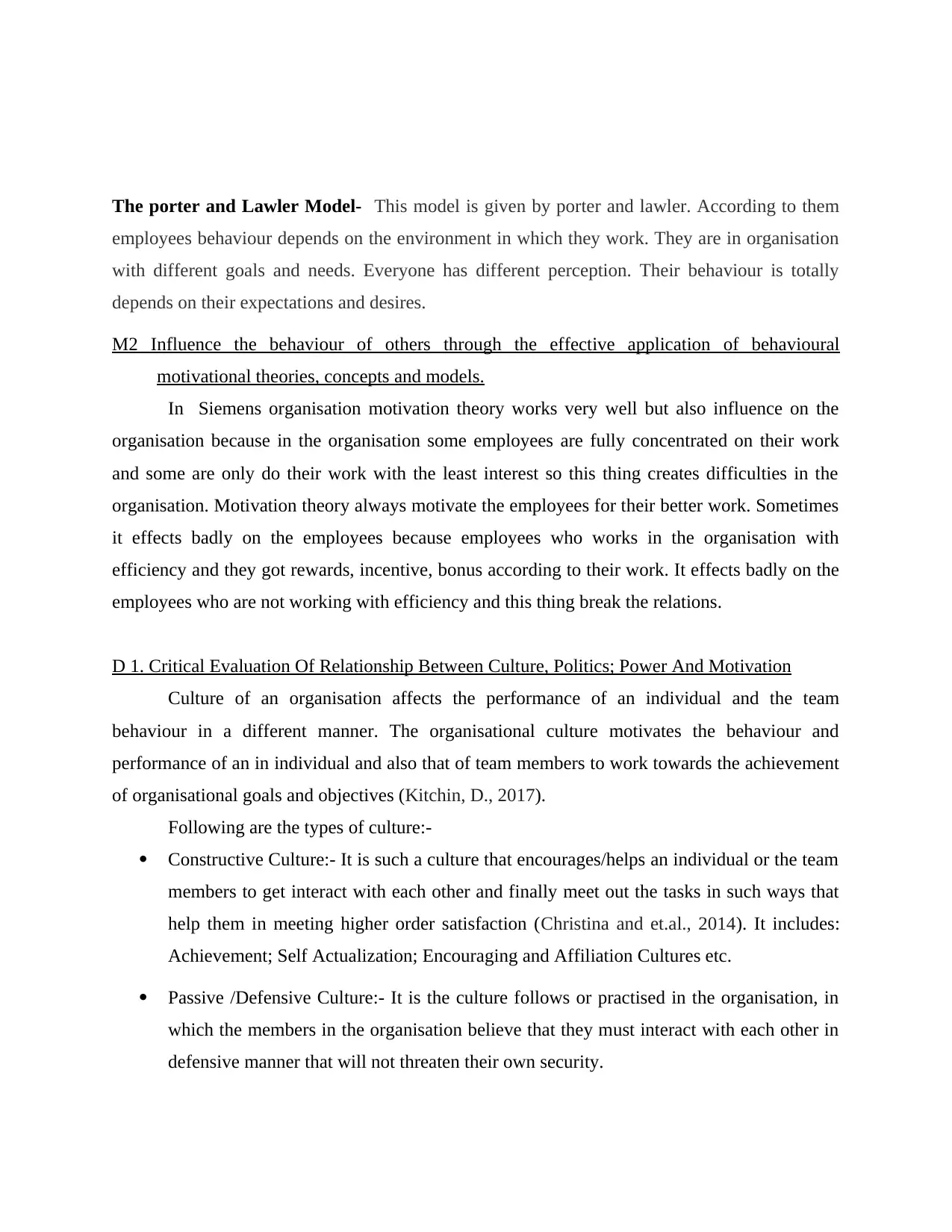
The porter and Lawler Model- This model is given by porter and lawler. According to them
employees behaviour depends on the environment in which they work. They are in organisation
with different goals and needs. Everyone has different perception. Their behaviour is totally
depends on their expectations and desires.
M2 Influence the behaviour of others through the effective application of behavioural
motivational theories, concepts and models.
In Siemens organisation motivation theory works very well but also influence on the
organisation because in the organisation some employees are fully concentrated on their work
and some are only do their work with the least interest so this thing creates difficulties in the
organisation. Motivation theory always motivate the employees for their better work. Sometimes
it effects badly on the employees because employees who works in the organisation with
efficiency and they got rewards, incentive, bonus according to their work. It effects badly on the
employees who are not working with efficiency and this thing break the relations.
D 1. Critical Evaluation Of Relationship Between Culture, Politics; Power And Motivation
Culture of an organisation affects the performance of an individual and the team
behaviour in a different manner. The organisational culture motivates the behaviour and
performance of an in individual and also that of team members to work towards the achievement
of organisational goals and objectives (Kitchin, D., 2017).
Following are the types of culture:-
Constructive Culture:- It is such a culture that encourages/helps an individual or the team
members to get interact with each other and finally meet out the tasks in such ways that
help them in meeting higher order satisfaction (Christina and et.al., 2014). It includes:
Achievement; Self Actualization; Encouraging and Affiliation Cultures etc.
Passive /Defensive Culture:- It is the culture follows or practised in the organisation, in
which the members in the organisation believe that they must interact with each other in
defensive manner that will not threaten their own security.
employees behaviour depends on the environment in which they work. They are in organisation
with different goals and needs. Everyone has different perception. Their behaviour is totally
depends on their expectations and desires.
M2 Influence the behaviour of others through the effective application of behavioural
motivational theories, concepts and models.
In Siemens organisation motivation theory works very well but also influence on the
organisation because in the organisation some employees are fully concentrated on their work
and some are only do their work with the least interest so this thing creates difficulties in the
organisation. Motivation theory always motivate the employees for their better work. Sometimes
it effects badly on the employees because employees who works in the organisation with
efficiency and they got rewards, incentive, bonus according to their work. It effects badly on the
employees who are not working with efficiency and this thing break the relations.
D 1. Critical Evaluation Of Relationship Between Culture, Politics; Power And Motivation
Culture of an organisation affects the performance of an individual and the team
behaviour in a different manner. The organisational culture motivates the behaviour and
performance of an in individual and also that of team members to work towards the achievement
of organisational goals and objectives (Kitchin, D., 2017).
Following are the types of culture:-
Constructive Culture:- It is such a culture that encourages/helps an individual or the team
members to get interact with each other and finally meet out the tasks in such ways that
help them in meeting higher order satisfaction (Christina and et.al., 2014). It includes:
Achievement; Self Actualization; Encouraging and Affiliation Cultures etc.
Passive /Defensive Culture:- It is the culture follows or practised in the organisation, in
which the members in the organisation believe that they must interact with each other in
defensive manner that will not threaten their own security.
⊘ This is a preview!⊘
Do you want full access?
Subscribe today to unlock all pages.

Trusted by 1+ million students worldwide
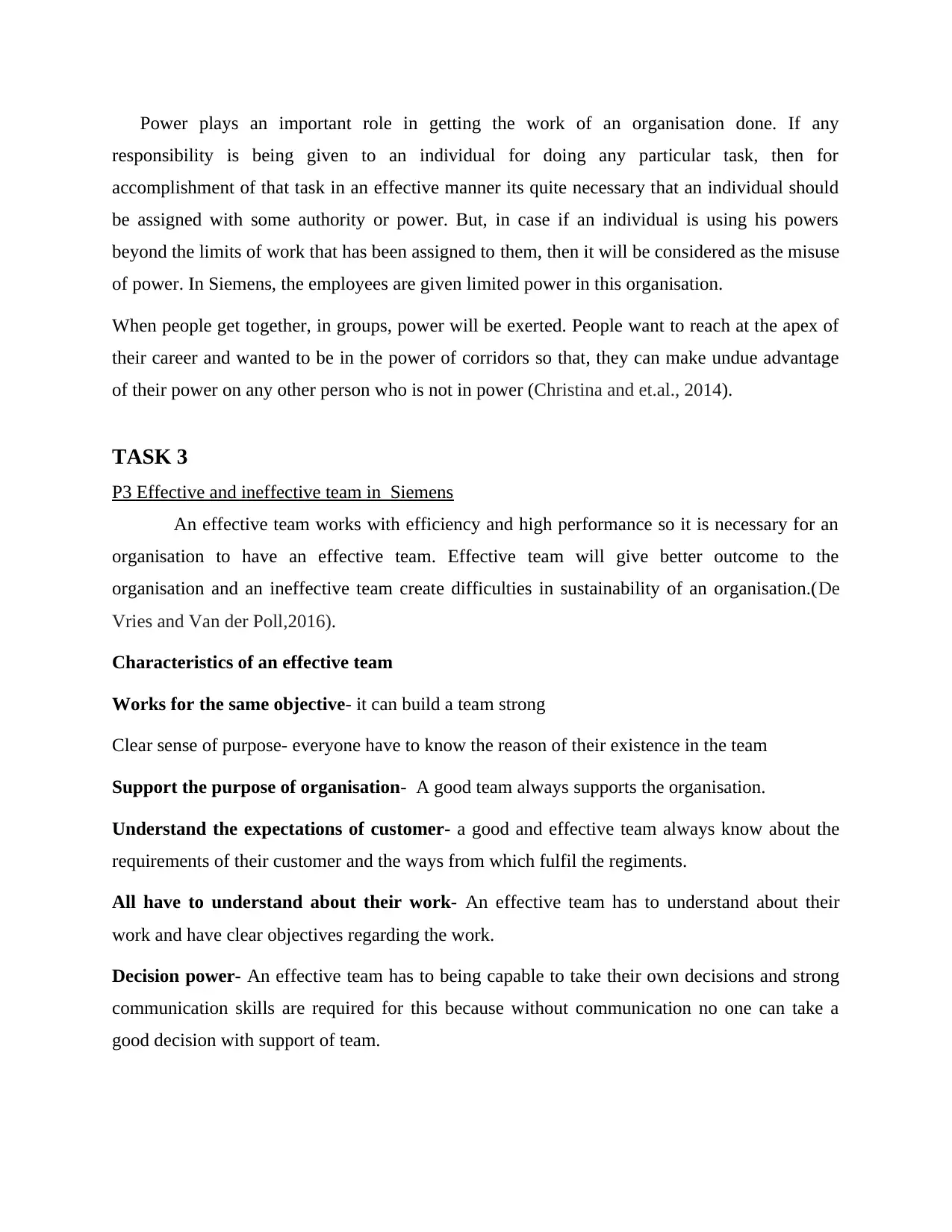
Power plays an important role in getting the work of an organisation done. If any
responsibility is being given to an individual for doing any particular task, then for
accomplishment of that task in an effective manner its quite necessary that an individual should
be assigned with some authority or power. But, in case if an individual is using his powers
beyond the limits of work that has been assigned to them, then it will be considered as the misuse
of power. In Siemens, the employees are given limited power in this organisation.
When people get together, in groups, power will be exerted. People want to reach at the apex of
their career and wanted to be in the power of corridors so that, they can make undue advantage
of their power on any other person who is not in power (Christina and et.al., 2014).
TASK 3
P3 Effective and ineffective team in Siemens
An effective team works with efficiency and high performance so it is necessary for an
organisation to have an effective team. Effective team will give better outcome to the
organisation and an ineffective team create difficulties in sustainability of an organisation.(De
Vries and Van der Poll,2016).
Characteristics of an effective team
Works for the same objective- it can build a team strong
Clear sense of purpose- everyone have to know the reason of their existence in the team
Support the purpose of organisation- A good team always supports the organisation.
Understand the expectations of customer- a good and effective team always know about the
requirements of their customer and the ways from which fulfil the regiments.
All have to understand about their work- An effective team has to understand about their
work and have clear objectives regarding the work.
Decision power- An effective team has to being capable to take their own decisions and strong
communication skills are required for this because without communication no one can take a
good decision with support of team.
responsibility is being given to an individual for doing any particular task, then for
accomplishment of that task in an effective manner its quite necessary that an individual should
be assigned with some authority or power. But, in case if an individual is using his powers
beyond the limits of work that has been assigned to them, then it will be considered as the misuse
of power. In Siemens, the employees are given limited power in this organisation.
When people get together, in groups, power will be exerted. People want to reach at the apex of
their career and wanted to be in the power of corridors so that, they can make undue advantage
of their power on any other person who is not in power (Christina and et.al., 2014).
TASK 3
P3 Effective and ineffective team in Siemens
An effective team works with efficiency and high performance so it is necessary for an
organisation to have an effective team. Effective team will give better outcome to the
organisation and an ineffective team create difficulties in sustainability of an organisation.(De
Vries and Van der Poll,2016).
Characteristics of an effective team
Works for the same objective- it can build a team strong
Clear sense of purpose- everyone have to know the reason of their existence in the team
Support the purpose of organisation- A good team always supports the organisation.
Understand the expectations of customer- a good and effective team always know about the
requirements of their customer and the ways from which fulfil the regiments.
All have to understand about their work- An effective team has to understand about their
work and have clear objectives regarding the work.
Decision power- An effective team has to being capable to take their own decisions and strong
communication skills are required for this because without communication no one can take a
good decision with support of team.
Paraphrase This Document
Need a fresh take? Get an instant paraphrase of this document with our AI Paraphraser
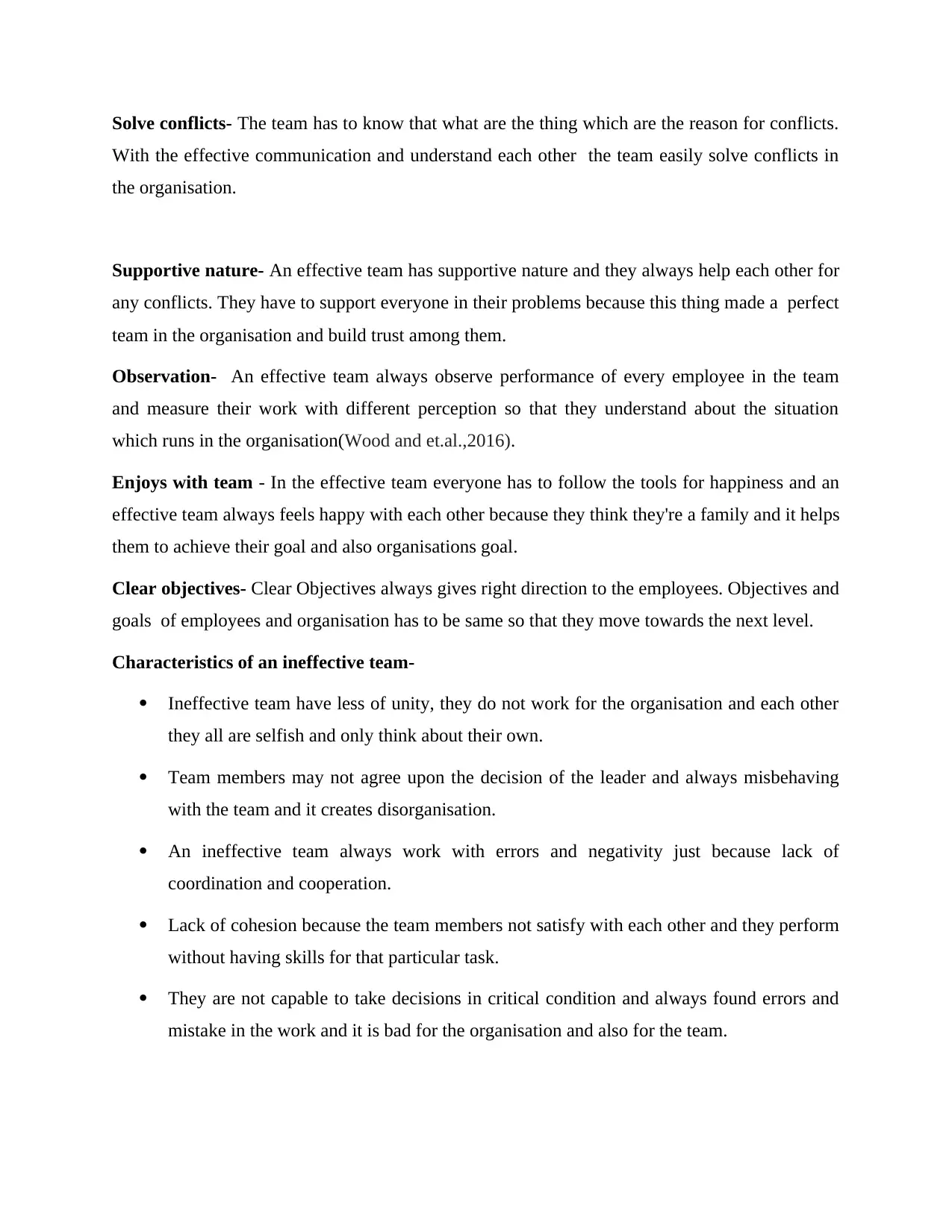
Solve conflicts- The team has to know that what are the thing which are the reason for conflicts.
With the effective communication and understand each other the team easily solve conflicts in
the organisation.
Supportive nature- An effective team has supportive nature and they always help each other for
any conflicts. They have to support everyone in their problems because this thing made a perfect
team in the organisation and build trust among them.
Observation- An effective team always observe performance of every employee in the team
and measure their work with different perception so that they understand about the situation
which runs in the organisation(Wood and et.al.,2016).
Enjoys with team - In the effective team everyone has to follow the tools for happiness and an
effective team always feels happy with each other because they think they're a family and it helps
them to achieve their goal and also organisations goal.
Clear objectives- Clear Objectives always gives right direction to the employees. Objectives and
goals of employees and organisation has to be same so that they move towards the next level.
Characteristics of an ineffective team-
Ineffective team have less of unity, they do not work for the organisation and each other
they all are selfish and only think about their own.
Team members may not agree upon the decision of the leader and always misbehaving
with the team and it creates disorganisation.
An ineffective team always work with errors and negativity just because lack of
coordination and cooperation.
Lack of cohesion because the team members not satisfy with each other and they perform
without having skills for that particular task.
They are not capable to take decisions in critical condition and always found errors and
mistake in the work and it is bad for the organisation and also for the team.
With the effective communication and understand each other the team easily solve conflicts in
the organisation.
Supportive nature- An effective team has supportive nature and they always help each other for
any conflicts. They have to support everyone in their problems because this thing made a perfect
team in the organisation and build trust among them.
Observation- An effective team always observe performance of every employee in the team
and measure their work with different perception so that they understand about the situation
which runs in the organisation(Wood and et.al.,2016).
Enjoys with team - In the effective team everyone has to follow the tools for happiness and an
effective team always feels happy with each other because they think they're a family and it helps
them to achieve their goal and also organisations goal.
Clear objectives- Clear Objectives always gives right direction to the employees. Objectives and
goals of employees and organisation has to be same so that they move towards the next level.
Characteristics of an ineffective team-
Ineffective team have less of unity, they do not work for the organisation and each other
they all are selfish and only think about their own.
Team members may not agree upon the decision of the leader and always misbehaving
with the team and it creates disorganisation.
An ineffective team always work with errors and negativity just because lack of
coordination and cooperation.
Lack of cohesion because the team members not satisfy with each other and they perform
without having skills for that particular task.
They are not capable to take decisions in critical condition and always found errors and
mistake in the work and it is bad for the organisation and also for the team.
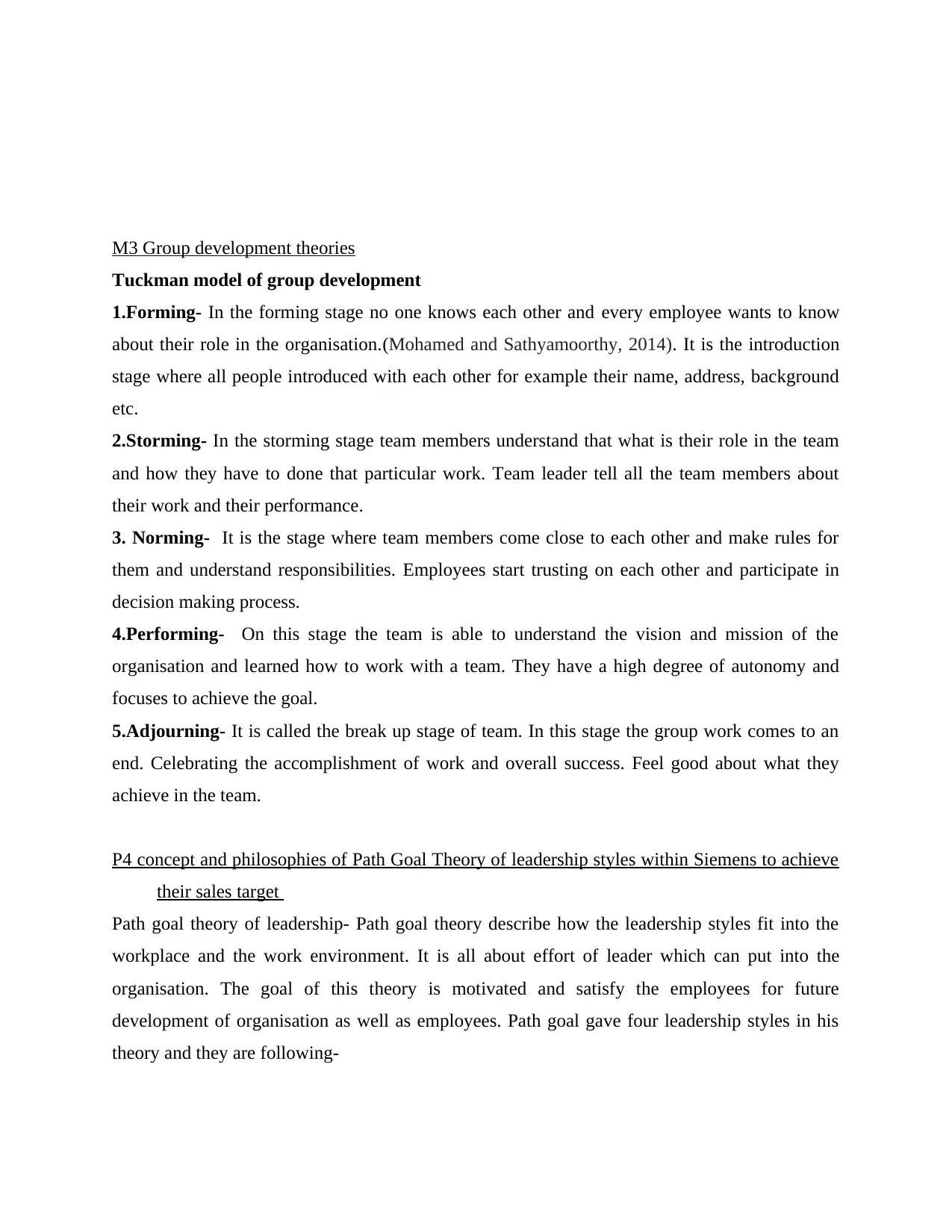
M3 Group development theories
Tuckman model of group development
1.Forming- In the forming stage no one knows each other and every employee wants to know
about their role in the organisation.(Mohamed and Sathyamoorthy, 2014). It is the introduction
stage where all people introduced with each other for example their name, address, background
etc.
2.Storming- In the storming stage team members understand that what is their role in the team
and how they have to done that particular work. Team leader tell all the team members about
their work and their performance.
3. Norming- It is the stage where team members come close to each other and make rules for
them and understand responsibilities. Employees start trusting on each other and participate in
decision making process.
4.Performing- On this stage the team is able to understand the vision and mission of the
organisation and learned how to work with a team. They have a high degree of autonomy and
focuses to achieve the goal.
5.Adjourning- It is called the break up stage of team. In this stage the group work comes to an
end. Celebrating the accomplishment of work and overall success. Feel good about what they
achieve in the team.
P4 concept and philosophies of Path Goal Theory of leadership styles within Siemens to achieve
their sales target
Path goal theory of leadership- Path goal theory describe how the leadership styles fit into the
workplace and the work environment. It is all about effort of leader which can put into the
organisation. The goal of this theory is motivated and satisfy the employees for future
development of organisation as well as employees. Path goal gave four leadership styles in his
theory and they are following-
Tuckman model of group development
1.Forming- In the forming stage no one knows each other and every employee wants to know
about their role in the organisation.(Mohamed and Sathyamoorthy, 2014). It is the introduction
stage where all people introduced with each other for example their name, address, background
etc.
2.Storming- In the storming stage team members understand that what is their role in the team
and how they have to done that particular work. Team leader tell all the team members about
their work and their performance.
3. Norming- It is the stage where team members come close to each other and make rules for
them and understand responsibilities. Employees start trusting on each other and participate in
decision making process.
4.Performing- On this stage the team is able to understand the vision and mission of the
organisation and learned how to work with a team. They have a high degree of autonomy and
focuses to achieve the goal.
5.Adjourning- It is called the break up stage of team. In this stage the group work comes to an
end. Celebrating the accomplishment of work and overall success. Feel good about what they
achieve in the team.
P4 concept and philosophies of Path Goal Theory of leadership styles within Siemens to achieve
their sales target
Path goal theory of leadership- Path goal theory describe how the leadership styles fit into the
workplace and the work environment. It is all about effort of leader which can put into the
organisation. The goal of this theory is motivated and satisfy the employees for future
development of organisation as well as employees. Path goal gave four leadership styles in his
theory and they are following-
⊘ This is a preview!⊘
Do you want full access?
Subscribe today to unlock all pages.

Trusted by 1+ million students worldwide
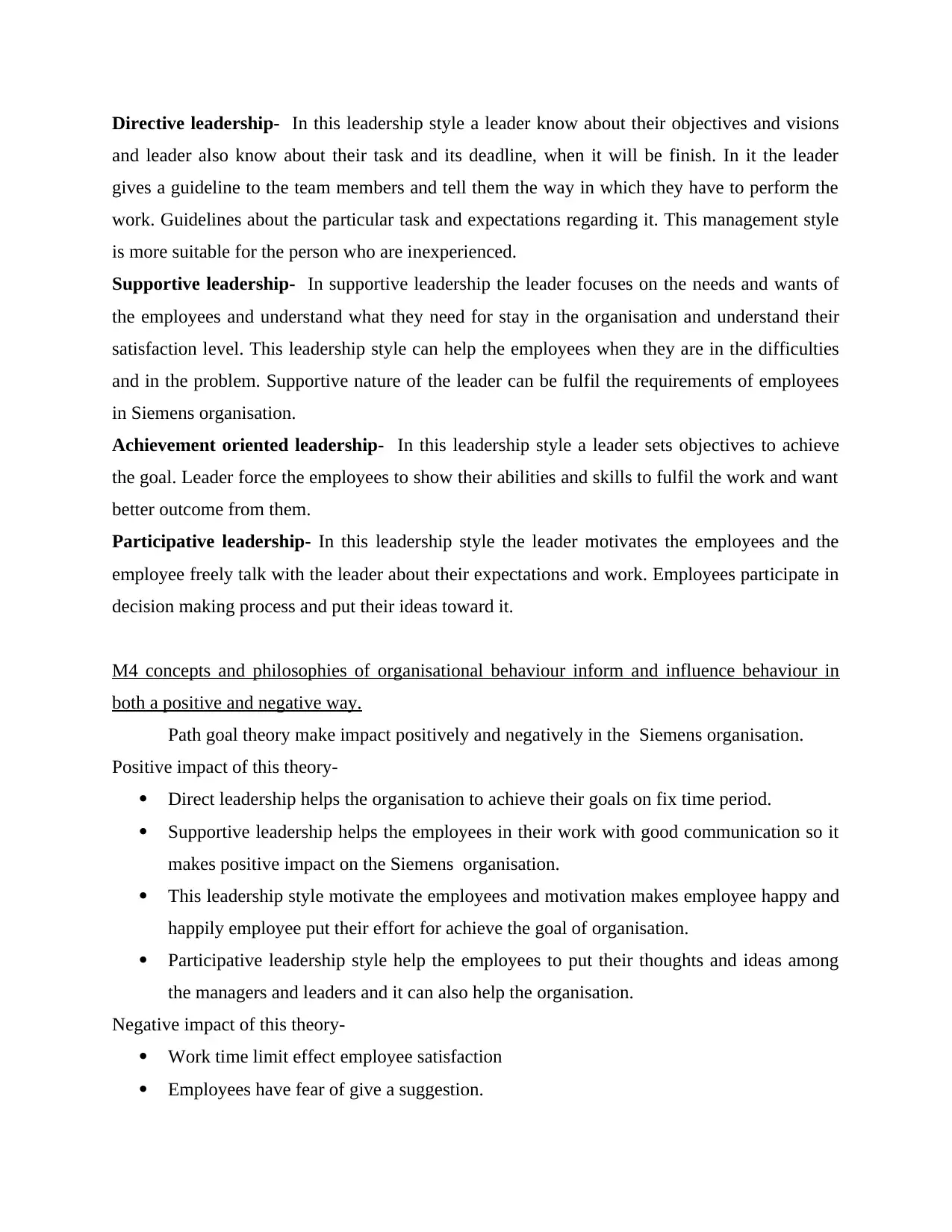
Directive leadership- In this leadership style a leader know about their objectives and visions
and leader also know about their task and its deadline, when it will be finish. In it the leader
gives a guideline to the team members and tell them the way in which they have to perform the
work. Guidelines about the particular task and expectations regarding it. This management style
is more suitable for the person who are inexperienced.
Supportive leadership- In supportive leadership the leader focuses on the needs and wants of
the employees and understand what they need for stay in the organisation and understand their
satisfaction level. This leadership style can help the employees when they are in the difficulties
and in the problem. Supportive nature of the leader can be fulfil the requirements of employees
in Siemens organisation.
Achievement oriented leadership- In this leadership style a leader sets objectives to achieve
the goal. Leader force the employees to show their abilities and skills to fulfil the work and want
better outcome from them.
Participative leadership- In this leadership style the leader motivates the employees and the
employee freely talk with the leader about their expectations and work. Employees participate in
decision making process and put their ideas toward it.
M4 concepts and philosophies of organisational behaviour inform and influence behaviour in
both a positive and negative way.
Path goal theory make impact positively and negatively in the Siemens organisation.
Positive impact of this theory-
Direct leadership helps the organisation to achieve their goals on fix time period.
Supportive leadership helps the employees in their work with good communication so it
makes positive impact on the Siemens organisation.
This leadership style motivate the employees and motivation makes employee happy and
happily employee put their effort for achieve the goal of organisation.
Participative leadership style help the employees to put their thoughts and ideas among
the managers and leaders and it can also help the organisation.
Negative impact of this theory-
Work time limit effect employee satisfaction
Employees have fear of give a suggestion.
and leader also know about their task and its deadline, when it will be finish. In it the leader
gives a guideline to the team members and tell them the way in which they have to perform the
work. Guidelines about the particular task and expectations regarding it. This management style
is more suitable for the person who are inexperienced.
Supportive leadership- In supportive leadership the leader focuses on the needs and wants of
the employees and understand what they need for stay in the organisation and understand their
satisfaction level. This leadership style can help the employees when they are in the difficulties
and in the problem. Supportive nature of the leader can be fulfil the requirements of employees
in Siemens organisation.
Achievement oriented leadership- In this leadership style a leader sets objectives to achieve
the goal. Leader force the employees to show their abilities and skills to fulfil the work and want
better outcome from them.
Participative leadership- In this leadership style the leader motivates the employees and the
employee freely talk with the leader about their expectations and work. Employees participate in
decision making process and put their ideas toward it.
M4 concepts and philosophies of organisational behaviour inform and influence behaviour in
both a positive and negative way.
Path goal theory make impact positively and negatively in the Siemens organisation.
Positive impact of this theory-
Direct leadership helps the organisation to achieve their goals on fix time period.
Supportive leadership helps the employees in their work with good communication so it
makes positive impact on the Siemens organisation.
This leadership style motivate the employees and motivation makes employee happy and
happily employee put their effort for achieve the goal of organisation.
Participative leadership style help the employees to put their thoughts and ideas among
the managers and leaders and it can also help the organisation.
Negative impact of this theory-
Work time limit effect employee satisfaction
Employees have fear of give a suggestion.
Paraphrase This Document
Need a fresh take? Get an instant paraphrase of this document with our AI Paraphraser
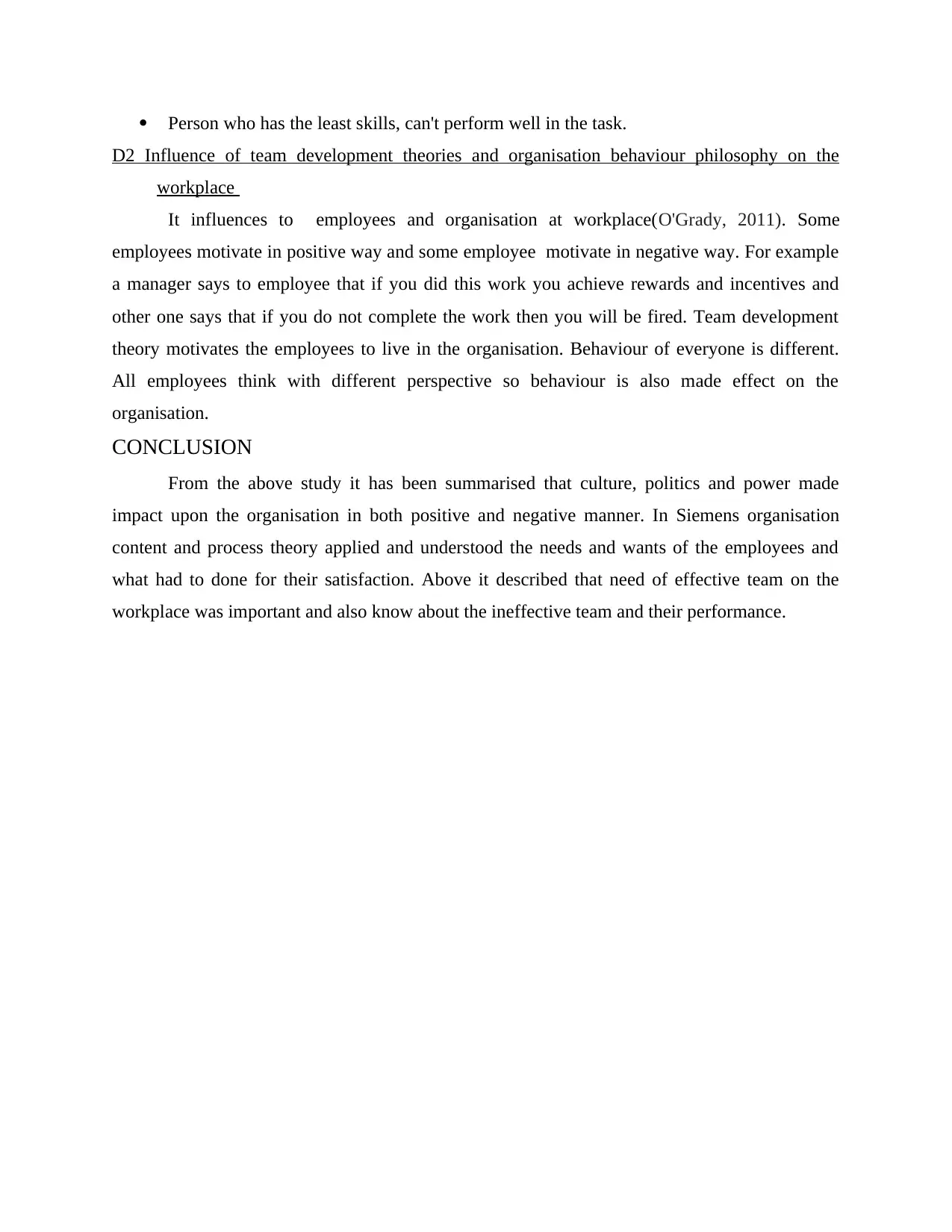
Person who has the least skills, can't perform well in the task.
D2 Influence of team development theories and organisation behaviour philosophy on the
workplace
It influences to employees and organisation at workplace(O'Grady, 2011). Some
employees motivate in positive way and some employee motivate in negative way. For example
a manager says to employee that if you did this work you achieve rewards and incentives and
other one says that if you do not complete the work then you will be fired. Team development
theory motivates the employees to live in the organisation. Behaviour of everyone is different.
All employees think with different perspective so behaviour is also made effect on the
organisation.
CONCLUSION
From the above study it has been summarised that culture, politics and power made
impact upon the organisation in both positive and negative manner. In Siemens organisation
content and process theory applied and understood the needs and wants of the employees and
what had to done for their satisfaction. Above it described that need of effective team on the
workplace was important and also know about the ineffective team and their performance.
D2 Influence of team development theories and organisation behaviour philosophy on the
workplace
It influences to employees and organisation at workplace(O'Grady, 2011). Some
employees motivate in positive way and some employee motivate in negative way. For example
a manager says to employee that if you did this work you achieve rewards and incentives and
other one says that if you do not complete the work then you will be fired. Team development
theory motivates the employees to live in the organisation. Behaviour of everyone is different.
All employees think with different perspective so behaviour is also made effect on the
organisation.
CONCLUSION
From the above study it has been summarised that culture, politics and power made
impact upon the organisation in both positive and negative manner. In Siemens organisation
content and process theory applied and understood the needs and wants of the employees and
what had to done for their satisfaction. Above it described that need of effective team on the
workplace was important and also know about the ineffective team and their performance.
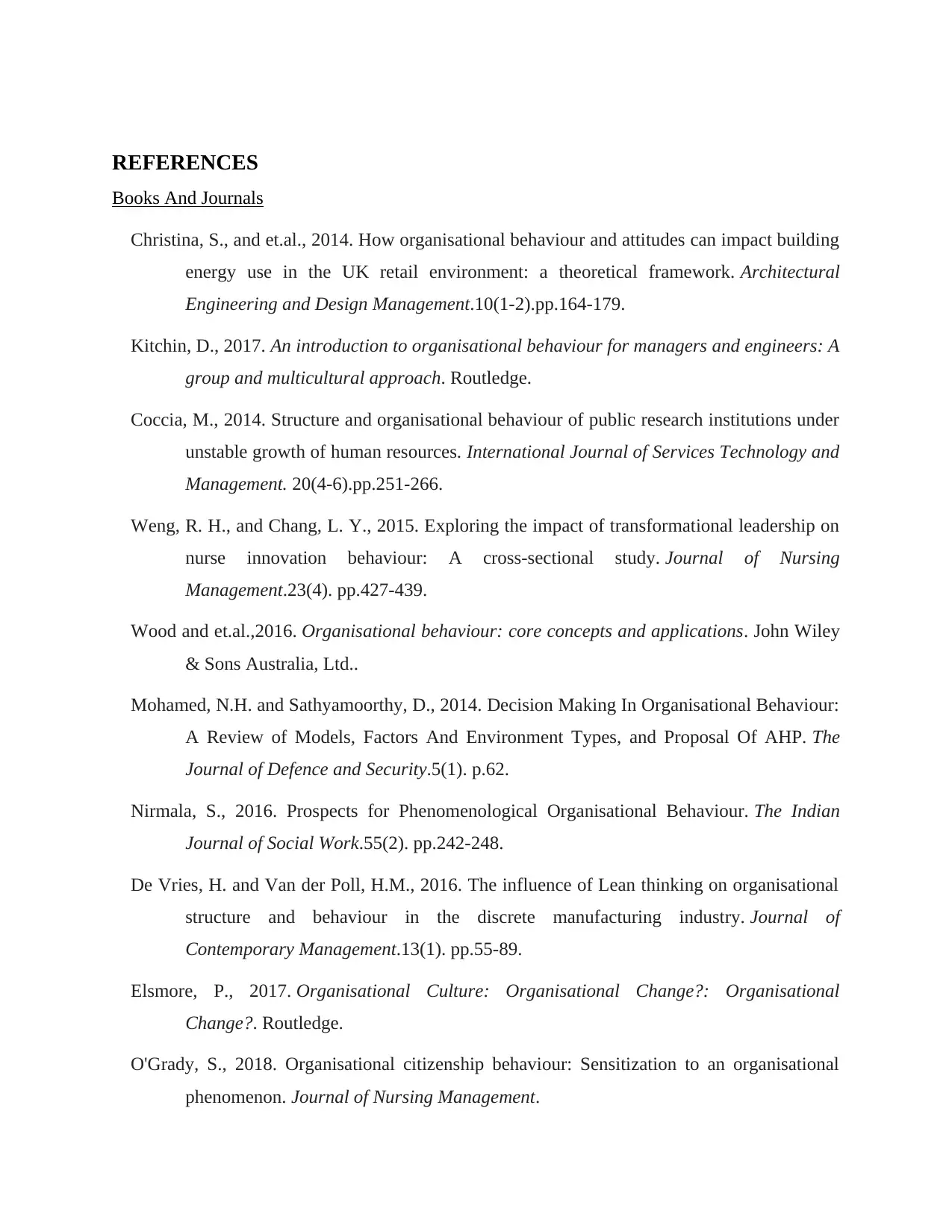
REFERENCES
Books And Journals
Christina, S., and et.al., 2014. How organisational behaviour and attitudes can impact building
energy use in the UK retail environment: a theoretical framework. Architectural
Engineering and Design Management.10(1-2).pp.164-179.
Kitchin, D., 2017. An introduction to organisational behaviour for managers and engineers: A
group and multicultural approach. Routledge.
Coccia, M., 2014. Structure and organisational behaviour of public research institutions under
unstable growth of human resources. International Journal of Services Technology and
Management. 20(4-6).pp.251-266.
Weng, R. H., and Chang, L. Y., 2015. Exploring the impact of transformational leadership on
nurse innovation behaviour: A cross‐sectional study. Journal of Nursing
Management.23(4). pp.427-439.
Wood and et.al.,2016. Organisational behaviour: core concepts and applications. John Wiley
& Sons Australia, Ltd..
Mohamed, N.H. and Sathyamoorthy, D., 2014. Decision Making In Organisational Behaviour:
A Review of Models, Factors And Environment Types, and Proposal Of AHP. The
Journal of Defence and Security.5(1). p.62.
Nirmala, S., 2016. Prospects for Phenomenological Organisational Behaviour. The Indian
Journal of Social Work.55(2). pp.242-248.
De Vries, H. and Van der Poll, H.M., 2016. The influence of Lean thinking on organisational
structure and behaviour in the discrete manufacturing industry. Journal of
Contemporary Management.13(1). pp.55-89.
Elsmore, P., 2017. Organisational Culture: Organisational Change?: Organisational
Change?. Routledge.
O'Grady, S., 2018. Organisational citizenship behaviour: Sensitization to an organisational
phenomenon. Journal of Nursing Management.
Books And Journals
Christina, S., and et.al., 2014. How organisational behaviour and attitudes can impact building
energy use in the UK retail environment: a theoretical framework. Architectural
Engineering and Design Management.10(1-2).pp.164-179.
Kitchin, D., 2017. An introduction to organisational behaviour for managers and engineers: A
group and multicultural approach. Routledge.
Coccia, M., 2014. Structure and organisational behaviour of public research institutions under
unstable growth of human resources. International Journal of Services Technology and
Management. 20(4-6).pp.251-266.
Weng, R. H., and Chang, L. Y., 2015. Exploring the impact of transformational leadership on
nurse innovation behaviour: A cross‐sectional study. Journal of Nursing
Management.23(4). pp.427-439.
Wood and et.al.,2016. Organisational behaviour: core concepts and applications. John Wiley
& Sons Australia, Ltd..
Mohamed, N.H. and Sathyamoorthy, D., 2014. Decision Making In Organisational Behaviour:
A Review of Models, Factors And Environment Types, and Proposal Of AHP. The
Journal of Defence and Security.5(1). p.62.
Nirmala, S., 2016. Prospects for Phenomenological Organisational Behaviour. The Indian
Journal of Social Work.55(2). pp.242-248.
De Vries, H. and Van der Poll, H.M., 2016. The influence of Lean thinking on organisational
structure and behaviour in the discrete manufacturing industry. Journal of
Contemporary Management.13(1). pp.55-89.
Elsmore, P., 2017. Organisational Culture: Organisational Change?: Organisational
Change?. Routledge.
O'Grady, S., 2018. Organisational citizenship behaviour: Sensitization to an organisational
phenomenon. Journal of Nursing Management.
⊘ This is a preview!⊘
Do you want full access?
Subscribe today to unlock all pages.

Trusted by 1+ million students worldwide
1 out of 12
Related Documents
Your All-in-One AI-Powered Toolkit for Academic Success.
+13062052269
info@desklib.com
Available 24*7 on WhatsApp / Email
![[object Object]](/_next/static/media/star-bottom.7253800d.svg)
Unlock your academic potential
Copyright © 2020–2025 A2Z Services. All Rights Reserved. Developed and managed by ZUCOL.





